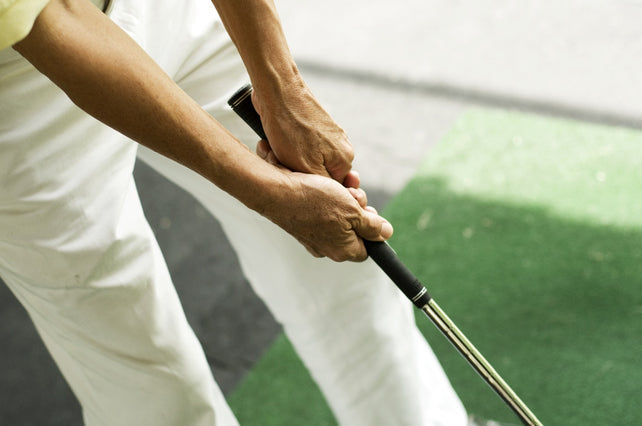Three Common Grips in Golf (with Pros and Cons for Each)
Jun 23, 2020
There’s no one exactly right way to play golf. Over the last six hundred or so years this game has been played, techniques and strategies have been constantly evolving.
Of course, there are basics that you’ll need to get right, but even now nothing is set in stone. Certain swings, movements, and clubs come and go like any other trend. New players will arrive with new techniques, and old techniques will become less popular.
Club grip is a great example of this. Golf grips are one of the fundamentals of the sport, and a different grip can have a dramatic effect on your swing. However, even about something so apparently basic, there’s never been any consensus on which is the best grip overall. Most instructors will teach the overlapping grip, for example, but some of the best players in the sport use a different grip entirely!
So, what are the differences between the grips? Which one’s right for you? We look into three of the most common grips in golf, discuss their advantages and disadvantages, and show you how an indoor golf simulator can help you choose between them.
The Ten-Finger Grip
The most basic club grip in the game, the ten-finger grip gets its name from the simple fact that all ten fingers touch the club. It’s also known by some as the neutral or “baseball” grip because it’s more or less the same way you would hold a baseball bat. This also makes many amateurs naturally gravitate to a ten-finger grip when they’re first starting out. It just feels right!
How to Do the Ten-Finger Grip
If you hold the club as you would with a baseball bat, you’re almost there. For right-handed players, the left hand (known as the leading hand) will be toward the top of the club while the right hand (known as the trailing hand) is below that. There should be no gap between the hands, and the first knuckles of the left hand should line up with the second knuckles of the right and vice versa.
The only thing to watch out for is the thumb of your left hand. Instead of wrapping around the shaft of the club, this should be pointing up, resting on the club and covered by the fingers of your right hand.
Advantages
1. It’s easy for beginners – There can be a lot of things to focus on when you first start playing golf, from swing to posture, to club selection and everything in between! Allowing them a neutral, natural grip means one less thing to worry about for the time being.
2. It’s the most natural feeling – Until players get used to it, some of the movements and grips in golf can feel a little awkward. Adopting the ten-finger grip feels comfortable and can lead to a more relaxed stroke in general.
3. It has greater impact power – All ten fingers are holding the club, which means all ten fingers can transfer power from the arms to the club at point of impact. Combined with more wrist flexibility—and a bigger snap-through in the swing—if handled correctly, it allows for a lot of shot power.
Disadvantages
1. The hands can operate independently – With a neutral grip, your hands aren’t really connected and can move somewhat independently of each other. Without the right strength and discipline, this can result in a power imbalance or messing up the swing sequence, resulting in a poor shot.
2. Too much freedom in the wrists – Although wrist freedom can be a blessing for extra shot power, it can also be a curse for control. Power should come from the entire swing, and an overreliance on the wrists can entrench bad habits as well as cause mishits.
The Overlapping Grip
Golf’s most utilized grip wasn’t popularized until the last century, by a professional British golfer named Harry Vardon. His newfound technique revolutionized the sport so much that, even to this day, the overlapping grip is also commonly known as the Vardon Grip. The majority of today’s PGA professionals use the overlapping grip, and it’s probably what you’ll be taught if you take golf lessons.
How to Do the Overlapping Grip
Begin with the ten-finger grip, but lift the pinky of the trailing hand and rest it in the groove between the index and middle finger of the leading hand. The thumb of the leading hand is still pointing down the club, and the trailing hand is moved closer to the leading hand so there is still no gap between them.

Advantages
1. It combines freedom and control – By making the hands a little more unified, the Vardon grip increases the amount of control you have over both wrists, helping them move as one but without reducing their freedom entirely.
2. It’s good for bigger hands – Those with longer fingers and bigger hands will find the overlapping grip more comfortable, as it partially wraps around the leading hand and not just the club.
3. It’s easier to follow the professionals – Modeling your swing and grip on what the professionals do is always a good idea. Adopting the most popular golf club grip will make this easier to do.
Disadvantages
1. There aren’t many disadvantages to the Vardon grip. No wonder it’s still so popular! The only drawbacks are that it can be slightly awkward for small hands to reach all the way around and that it sacrifices the extra squeeze of power available from a ten-finger grip.
The Interlocking Grip
What do Tiger Woods, Jack Nicklaus, and Rory McIlroy—some of the greatest golfers in history—have in common? They don’t use the overlapping grip! Instead, these pros favor a variation called the interlocking grip and, if they’re finding huge success with it, there’s no reason why you can’t, either!
How to Do the Interlocking Grip
With the interlocking grip, the pinky of the trailing hand is now fully between the index and middle fingers of the leading hand, instead of just resting on top of the space between them. It means the index finger of the leading hand is now between the pinky and ring finger of the trailing hand, effectively “interlocking” both hands.

Advantages
1. It locks the hands and wrists together – With the interlocking grip, both hands effectively act as one fluid unit. This gives you much better control without having to think much about what your wrists are doing.
2. It reduces the tension on the club – With all ten fingers back on the club, and the interlock naturally helping you hold it, you don’t need to put so much pressure on the grip. This helps you avoid choking the club and allows for a more fluid swing.
3. It’s well-suited to small hands – Players with small hands, such as children and female golfers, will find the interlocking grip more comfortable than the overlapping grip.
Disadvantages
Although some big-name players swear by the interlocking grip, it’s not necessarily a magic bullet for your game. There are some disadvantages, including:
1. It can be an awkward golf club grip for big hands.
2. It can reduce wrist movement too much, minimizing the power you get from the snap-through and making big drives harder without a perfect swing.
3. Because it makes you rely much more on your whole body for power and accuracy, it can amplify existing problems with your swing and posture.
4. It can seem very unnatural to begin with, especially for newer players, making it frustrating as you get used to it.
Which Golf Grip’s Right for You?
Ultimately, deciding on which grip you’ll use will come down to one simple rule: Choose the one which works best for you! As you can see, there are advantages and disadvantages to each grip, and not every player will find every grip to their liking.
Take the time to road-test each grip and see which one feels comfortable and fits in naturally with your swing. Practically every golfer has their own individual style of play—you should find a grip that suits it, not the other way around!
One of the simplest ways to do this is with a home golf simulator. As one of the best golf simulators on the market today, FSX 2020 not only gives you the freedom to practice shots over and over again—on some of the world’s most iconic courses, no less—but also gives you invaluable metrics and feedback with which to judge your grip.
With the power of the FSX 2020 golf simulator, it’s easy to analyze and refine every aspect of your game. To get the best golf simulator into your home, contact us online or call us at (858) 880-0179 today!




































